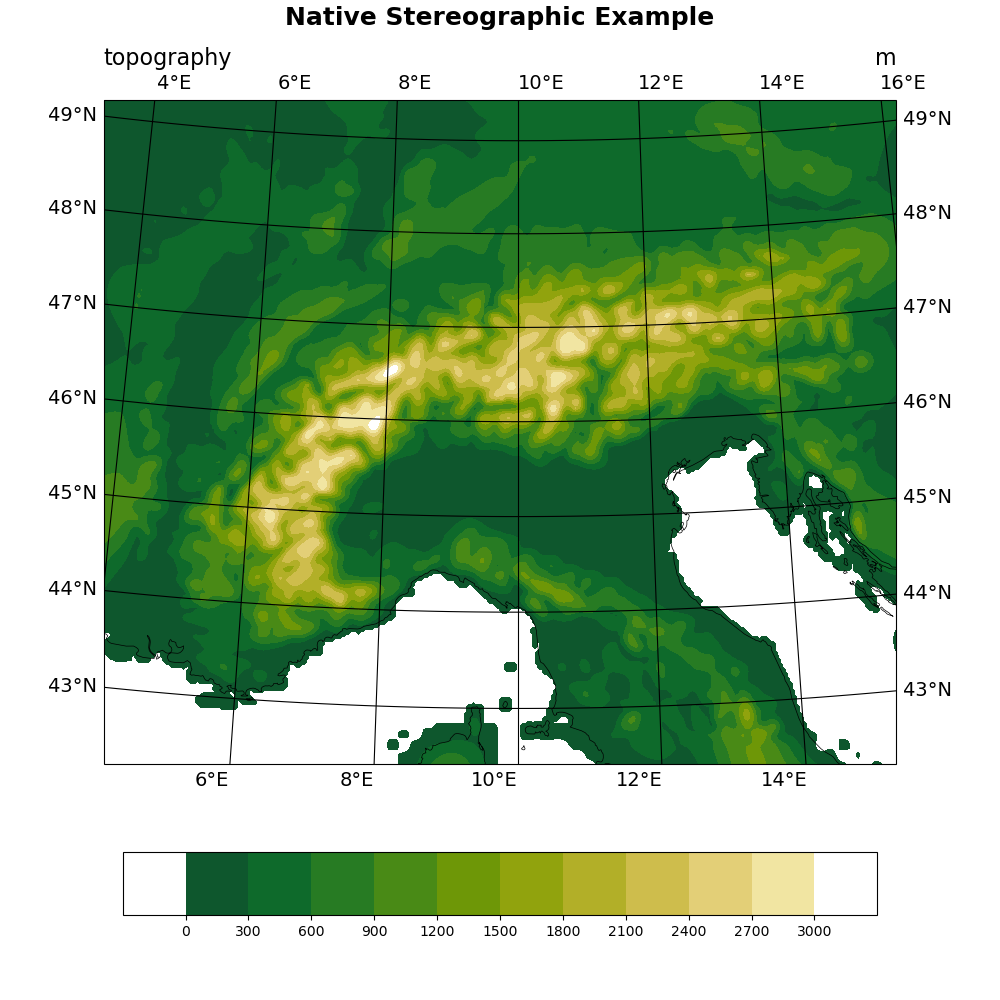Note
Go to the end to download the full example code
NCL_native_1.py#
- This script illustrates the following concepts:
Drawing filled contours over a stereographic map
Reading in data from binary files
Setting the view of a stereographic map
Turning on map tickmark labels with degree symbols
Choosing colors from a pre-existing colormap
Making the ends of the colormap white
Using best practices when choosing plot color scheme to accomodate visual impairments
- See following URLs to see the reproduced NCL plot & script:
Original NCL script: https://www.ncl.ucar.edu/Applications/Scripts/native_1.ncl
Original NCL plot: https://www.ncl.ucar.edu/Applications/Images/native_1_lg.png
Import packages:
import numpy as np
import cartopy.crs as ccrs
import matplotlib.pyplot as plt
import cmaps
import geocat.viz as gv
import geocat.datafiles as gdf
Read in data:
nlat = 293
nlon = 343
# Read in binary topography file using big endian float data type (>f)
topo = np.fromfile(gdf.get("binary_files/topo.bin"), dtype=np.dtype('>f'))
# Reshape topography array into 2-D array
topo = np.reshape(topo, (nlat, nlon))
# Read in binary latitude/longitude file using big endian float data type (>f)
latlon = np.fromfile(gdf.get("binary_files/latlon.bin"), dtype=np.dtype('>f'))
latlon = np.reshape(latlon, (2, nlat, nlon))
lat = latlon[0]
lon = latlon[1]
Plot:
# Generate figure (set its size (width, height) in inches)
fig = plt.figure(figsize=(10, 10))
# Create cartopy axes and add coastlines
ax = plt.axes(projection=ccrs.NorthPolarStereo(central_longitude=10))
ax.coastlines(linewidths=0.5)
# Set extent to show particular area of the map ranging from 4.25E to 15.25E
# and 42.25N to 49.25N
ax.set_extent([4.25, 15.25, 42.25, 49.25], ccrs.PlateCarree())
# Create colormap by choosing colors from existing colormap
# The brightness of the colors in cmocean_speed increase linearly. This
# makes the colormap easier to interpret for those with vision impairments
cmap = cmaps.cmocean_speed
# Specify the indices of the desired colors
index = [0, 200, 180, 160, 140, 120, 100, 80, 60, 40, 20, 0]
color_list = [cmap[i].colors for i in index]
# make the starting color and end color white
color_list[0] = [1, 1, 1] # [red, green, blue] values range from 0 to 1
color_list[-1] = [1, 1, 1]
# Plot contour data, use the transform keyword to specify that the data is
# stored as rectangular lon,lat coordinates
contour = ax.contourf(lon,
lat,
topo,
transform=ccrs.PlateCarree(),
levels=np.arange(-300, 3301, 300),
extend='neither',
colors=color_list)
# Create colorbar
plt.colorbar(contour,
ax=ax,
ticks=np.arange(0, 3001, 300),
orientation='horizontal',
aspect=12,
pad=0.1,
shrink=0.8)
# Use geocat-viz utility function to add gridlines to the map
gl = gv.add_lat_lon_gridlines(
ax,
color='black',
labelsize=14,
xlocator=np.arange(4, 18, 2), # longitudes for gridlines
ylocator=np.arange(43, 50)) # latitudes for gridlines
# Add padding between figure and longitude labels
gl.xpadding = 12
# Use geocat.viz.util function to easily set left and right titles
gv.set_titles_and_labels(ax,
lefttitle="topography",
lefttitlefontsize=16,
righttitle="m",
righttitlefontsize=16)
# Add a main title above the left and right titles
plt.title("Native Stereographic Example", y=1.1, size=18, fontweight="bold")
# Remove whitespace around plot
plt.tight_layout()
# Show the plot
plt.show()

Total running time of the script: (0 minutes 3.831 seconds)